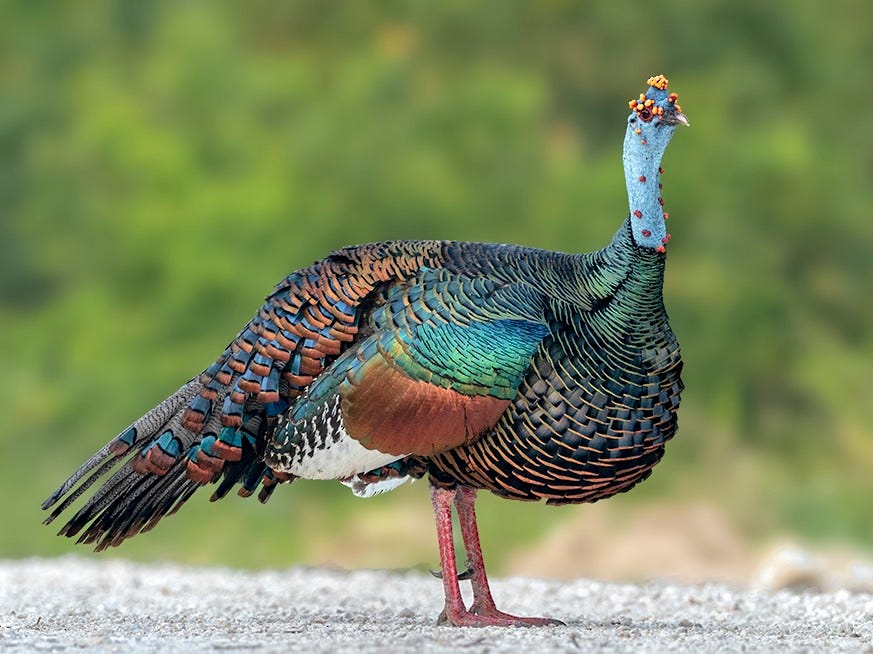The world’s "ugliest" birds
(And no, I’m not talking about my sister! Hehe. Kidding I love her very much and she’s not ugly but I needed someone as the punchline)
While I love birds (and my sister!) very much, I have to say that some birds look less pleasant than others. Some birds are elegant, or are brilliant flying jewels. Others have intoxicating eyes or bright red cheeks.
But we also have baldies with layers of wrinkly skin, cruel-looking, beady eyes. And we even have birds that poop on themselves! (More on that in Tuesday’s newsletter.)
But each bird still look good to their mates, so let’s not judge them too harshly.
King Vulture
They may be called Kings, but there’s nothing royal about the way they look (except, I suppose, Prince William is also bald?)
These birds are very large, and predominantly white, with a bald head and neck that is brilliantly coloured! Splashes of yellow, orange, blue, purple, and red adorn their bald heads, and a noticeable orange fleshy, bulbous ‘caruncle’ grows from the top of their beaks.
Like all vultures, the King Vulture is a scavenger - but their large size means they are often the bird that makes the first cut into a fresh carcass.
There are some theories on how the king vulture earned the "king" part of its common name - on theory is that the name is a reference to its habit of displacing smaller vultures from a carcass and eating its fill while they wait. It seems the people who named this birds we not fans of the royal family, then.
(RIP Lizzie)
Ocellated Turkey
Ocellated Turkeys are actually super striking, brightly-coloured, and quite beautiful in my eyes! Unfortunately, their sky blue necks and heads are often peppered with a number of orange or red nodules, and a type of leathery snood that dangles limply from their beaks…
These nodules are also usually larger and more pronounced on males Ocellated Turkeys.
Those snoods are so interesting! Only two birds in the whole world have prominent snoods: the wild turkey and the ocellated turkey.
Scientists haven't found any specific function for the snood. But we do know that during mating rituals, when males are strutting their stuff, the snood can fill up with blood and hang over the beak prominently.
Females seem to prefer to mate with long-snooded males. And during territorial disputes and mating rituals, males with shorter snoods will give in to males with longer snoods.
When you zoom out a little, you’ll appreciate the Ocellated Turkey for their unique beauty.
They can only be found on the Yucatán Peninsula of North America, which includes land in Mexico, Belize, and Guatemala. These areas are heavily forested, and despite the turkey’s large size and eye-popping plumage, they lurk mostly unseen, on the ground, amid thick foliage.
Northern Bald Ibis
Oops, it looks like all the birds I have rounded up for this list are bald - I think there’s some personal bias here!
But these guys honestly look so interesting - with their fabulous crest of elongated feathers, they remind me a little of Yzma, from the Emperor’s New Groove!
Northern Bald Ibises are mostly found across the Middle East, and parts of Africa and Europe. As you’ll probably imagine, those areas are really, really hot. The bare, dark head of the Northern Bald Ibis actually fulfills a thermoregulatory function. Darker pigments provide animals with benefits such as protection against UV rays - we see this not just in birds, but even in humans from Africa who have darker skin!
Plus, bare and ‘highly vascularised’ head skin helps birds with dissipating heat.
‘Highly vascularised’ is a term to mean that the body part has a lot of blood vessels. These blood vessels helps to pump blood throughout that body part - having more blood vessels along a bird’s bald head means there’s more blood flow to that area, which allows heat to escape more easily.
Anyway, I really don’t think they’re that ugly. Look at those gorgeous jewel-toned feathers!
Beauty is in the eye of the beholder, and for Northern Bald Ibises, their partners sure find them beautiful! These ibises are sexually monogamous and have just one partner for their whole lives! (Since learning about sexually promiscuous birds, I find their monogamous nature quite sweet. Other species aren’t as loyal - there’s a type of bird where 95% of females mate with more than one male during each nesting period. Read Sept 1 2022’s post about this!)
That’s all for today’s post. As interesting-looking as these birds are, I don’t think they are all that ugly!








